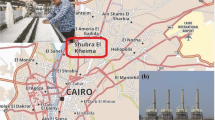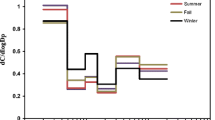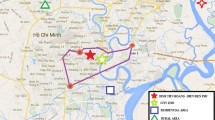Abstract
The objective of this study was to determine the size and composition of atmospheric aerosols in the downtown area of the city of São Paulo, Brazil, for a polluted and an unpolluted period. Aerosols were sampled with a portable air sampler (PAS), Micro-Orifice Uniform Deposit Impactor (MOUDI), and Scanning Mobility Particle Sizer. At the study site, air quality is poor, especially during the winter, high concentrations of pollutants being emitted primarily by the light- and heavy-duty vehicle fleet. We analyzed mass, black carbon (BC), Al, Si, P, S, Cl, K, Ca, Ti, V, Cr, Mn, Fe, Ni, Cu, Zn, Br, Rb, Sn, Zr, and Pb. During the polluted period, diurnal PM10 was higher than nocturnal PM10, whereas the inverse was true during the unpolluted period. The FPM was rich in BC, S, and Pb, whereas CPM was rich in Al, Si, Ca, Ti, and Fe. Mass balance was performed by category: ammonium sulfate, sodium chloride, crustal material, BC, and other. The PAS-determined FPM was mainly BC. The MOUDI-determined FPM crustal material explained more mass than did ammonium sulfate and BC during the polluted period, whereas ammonium sulfate had the largest mass during the unpolluted period. Crustal material was the major CPM component, followed by ammonium sulfate and BC. During the unpolluted period, FPM concentrations were lower, whereas those of ammonium sulfate were relatively higher, especially at night, and particle number was inversely proportional to particle size. Aerosol growth was more intense during the polluted period.
Similar content being viewed by others
References
Andrade, M. F. (1993). Identificação de fontes da matéria particulada do aerossol atmosférico de São Paulo. Tese de Doutorado, IF-USP.
Andrade, M. F., Orsini, C., & Maenhaut, W. (1994). Relation between aerosol sources and meteorological parameters for inhalable atmospheric particles in São Paulo city, Brazil. Atmospheric Environment, 28(14), 2307–2315.
Artaxo, P., & Orsini, C. (1987). PIXE and receptor models applied to remote aerosol source apportionment in Brazil. Nuclear Instruments and Methods in Physics Research B, 22, 259–263.
Asmi, E., Antola, M., Yli-Tuomi, T., Jantunen, M., Aarnio, P., Makela, T., et al. (2009). Driver and passenger exposure to aerosol particles in buses and trams in Helsinki, Finland. Science of the Total Environment, 407(8), 2860–2867.
Binkowski, F. S., & Shankar, U. (1995). The regional particulate model 1. Model description and preliminary results. Journal of Geophysical Research, 100(D12), 26191–26209.
Cabada, J. C., Rees, S., Takahama, S., Khlystov, A., Pandis, S. N., Davidson, C. I., et al. (2004). Mass Size Distributions and size resolved chemical composition of fine particulate matter at the Pittsburgh supersite. Atmospheric Environment, 38, 3127–3141.
Castanho, A. D. A., & Artaxo, P. (2001). Wintertime and summertime São Paulo aerosol source apportionment study. Atmospheric Environment, 35, 4889–4902.
CETESB (2002). Relatório de Qualidade do Ar no Estado de São Paulo. Companhia de Tecnologia de Saneamento Ambiental, São Paulo, Brasil Série Relatórios. http://www.cetesb.sp.gov.br/Ar/publicacoes.asp.
CETESB (2007). Relatório de Qualidade do Ar no Estado de São Paulo. Companhia de Tecnologia de Saneamento Ambiental, São Paulo, Brasil Série Relatórios. http://www.cetesb.sp.gov.br/Ar/publicacoes.asp.
Chow, J. C., Doraiswamy, P., Watson, J. G., Antony Chen, L. W., Hang Ho, S. S., & Soerman, D. A. (2008). Advances in integrated and continuous measurements for particle mass and chemical composition. Journal of the Air & Waste Management Association, 58, 141–163. doi:10.3155/1047-3289.58.2.141. ISSN:1047-3289.
Chung, A., Chang, D. P. Y., Kleeman, M. J., Perry, K. D., Cahill, T. A., Dutcher, D., et al. (2001). Comparison of real-time instruments used to monitor airborne particulate matter. Journal of the Air & Waste Management Association, 51, 109–120.
Hughes, L. S., Cass, G. R., Gone, J., Ames, M., & Olmez, I. (1998). Physical and chemical characterization of the atmospheric ultrafine particles in the Los Angeles Area. Environmental Science & Technology, 32, 1153–1161.
Johansson, S. A. E., & Campbell, J. L. (1988). PIXE, a novel technique for elemental analysis. John Wiley & Sons.
Jun, M., & Stein, M. L. (2004). Statistical comparison of observed and CMAQ modeled daily sulfate levels. Atmospheric Environment, 38, 4427–4436.
Kim, D., Gautam, M., & Gera, D. (2002). Parametric studies on the formation of diesel particulate matter via nucleation and coagulation modes. Journal of Aerosol Science, 33, 1609–1621.
Marple, V. A., Rubow, K. L., Ananth, G. P., & Fissan, H. J. (1986). Micro-orifice uniform impactor. Journal of Aerosol Science, 17, 489–494.
McMurry, P., Wang, X., Park, K., & Ehara, K. (2002). The relationship between mass and mobility for atmospheric particles: a new technique for measuring particle density. Aerosol Science and Technology, 36, 227–238.
Miranda, R. M., Andrade, M. F., Worobiec, A., & Grieken, R. V. (2002). Characterization of aerosol particles in São Paulo Metropolitan Area. Atmospheric Environment, 36, 345–352.
Morawska, L., Thomas, S., Gilbert, D., Greenaway, C., & Rijnders, E. (1999). A study of the horizontal and vertical profile of submicrometer particles in relation to a busy road. Atmospheric Environment, 33, 1261–1274.
Prospero, J. M., Charlson, R. J., Mohnen, V., Jaenicke, R., Delany, A. C., Moyers, J., et al. (1983). The atmospheric aerosol system: an overview. Reviews of Geophysics and Space Physics, 21(7), 1607–1629.
Reid, J. S., Hobbs, P. V., Liousse, C., Martins, J. V., Weiss, R. E., & Erck, T. F. (1998). Comparison of techniques for measuring short-wave absorption and black carbon content of aerosol from biomass burning in Brazil. Journal of Geophysical Research, 103(D24), 32031.
Sánchez-Ccoyllo, O. R., Ynoue, R. Y., Martins, L. D., & Andrade, M . F. (2006). Impacts of ozone precursor limitation and meteorological variables on ozone concentration in São Paulo, Brazil. Atmospheric Environment, 40, 552–562.
Schwartz, J. (1991). Air pollution and daily mortality in Philadelphia. Presented at the Meeting of the American Lung Association, Anaheim, CA.
Seinfeld, J. H., & Pandis, S. N. (1998). Atmospheric chemistry and physics: From air pollution to climate change. New York: Wiley.
Spektor, D. M., Hofmeister, V. A., Artaxo, P., Brague, J. A. P., Echelar, F., Nogueira, D. P., et al. (1991). Effects of heavy industrial pollution on respiratory function in the children of Cubatao, Brazil: a preliminary report. Environmental Health Perspectives, 94, 51–54.
Tabacniks, M., Orsini, C., & Artaxo, P. (1987). PIXE analysis for air pollution source apportionment in urban areas of Brazil. Nuclear Instruments and Methods in Physics Research B, 22, 315–318.
Van Espen, P., Janssens, K., & Nobels, J. (1986). AXIL-PC software for the analysis of complex X-ray spectra. Chemometrics and Intelligent Laboratory Systems, 1, 109–114.
Watson, J. G., Zhu, T., Chow, J. C., Engelbrecht, J., Fujita, E. M., & Wilson, W. E. (2002). Receptor modeling application framework for particle source apportionment. Chemosphere, 49, 1093–1136.
Ynoue, R. Y., & Andrade, M. F. (2004). Size-resolved mass balance of aerosol particles over the São Paulo Metropolitan Area of Brazil Aerosol Science and Technology.
Yu, J. Z., Yang, H., Zhang, H. Y., & Lau, A. K. H. (2004). Size distributions of water-soluble organic carbon in ambient aerosols and its size-resolved thermal characteristics. Atmospheric Environment, 38, 1061–1071.
Zhu, Y., & Hinds, W. C. (2002). Concentration and size distribution of ultrafine particles near a major highway. Journal of the Air & Waste Management Association, 52, 1032–1042. ISSN:1047-3289.
Author information
Authors and Affiliations
Corresponding author
Rights and permissions
About this article
Cite this article
de Almeida Albuquerque, T.T., de Fátima Andrade, M. & Ynoue, R.Y. Characterization of atmospheric aerosols in the city of São Paulo, Brazil: comparisons between polluted and unpolluted periods. Environ Monit Assess 184, 969–984 (2012). https://doi.org/10.1007/s10661-011-2013-y
Received:
Accepted:
Published:
Issue Date:
DOI: https://doi.org/10.1007/s10661-011-2013-y




